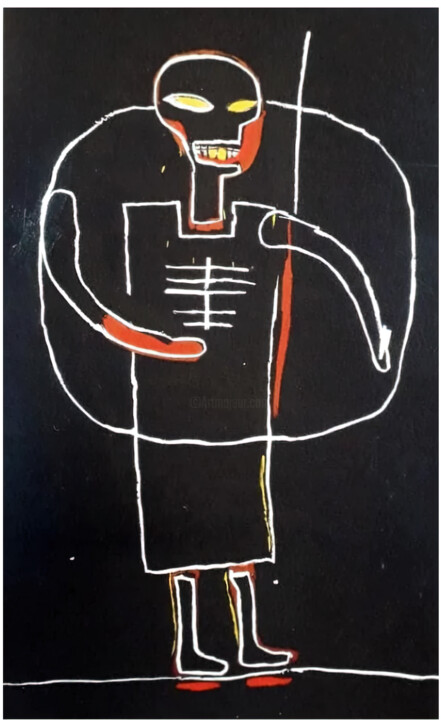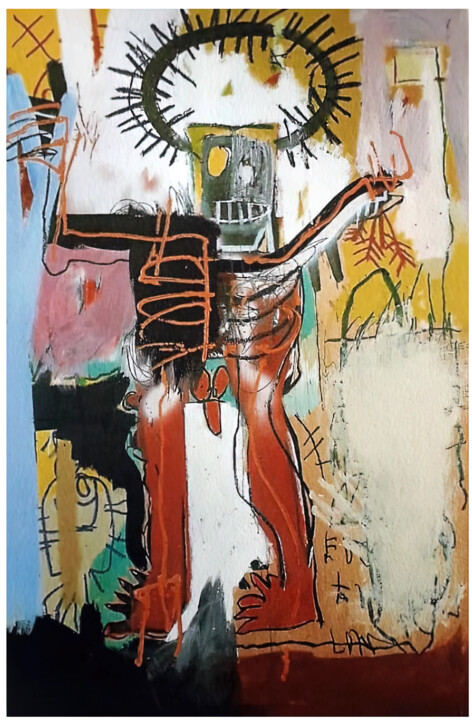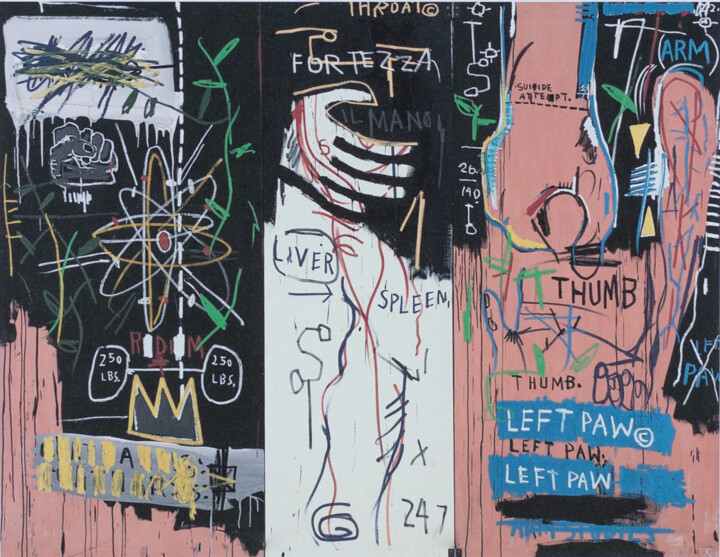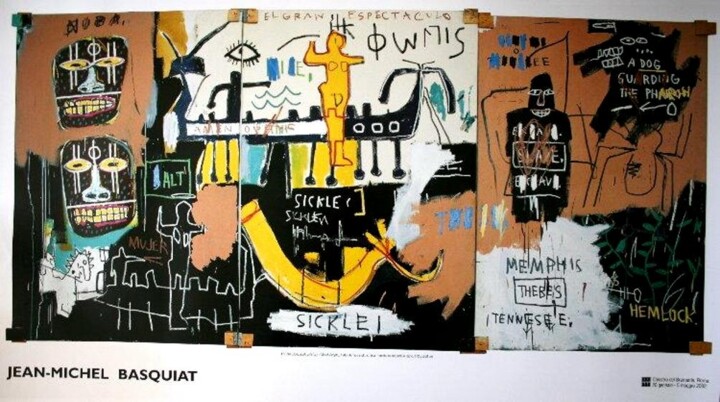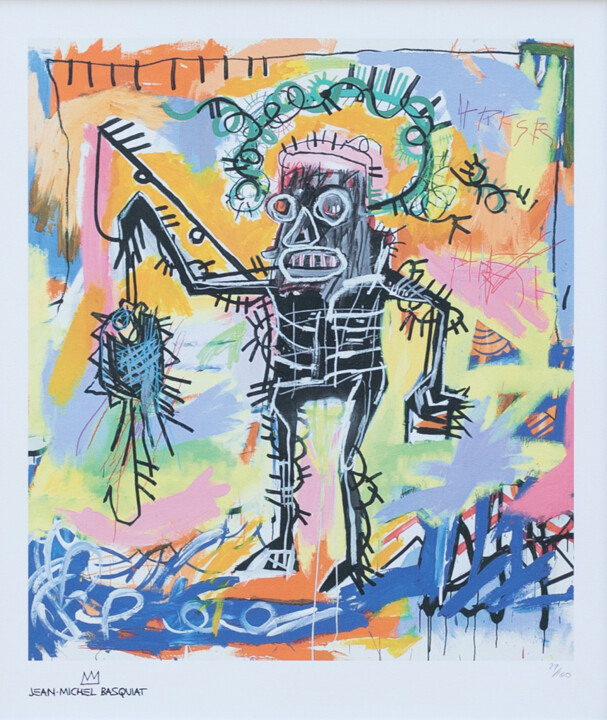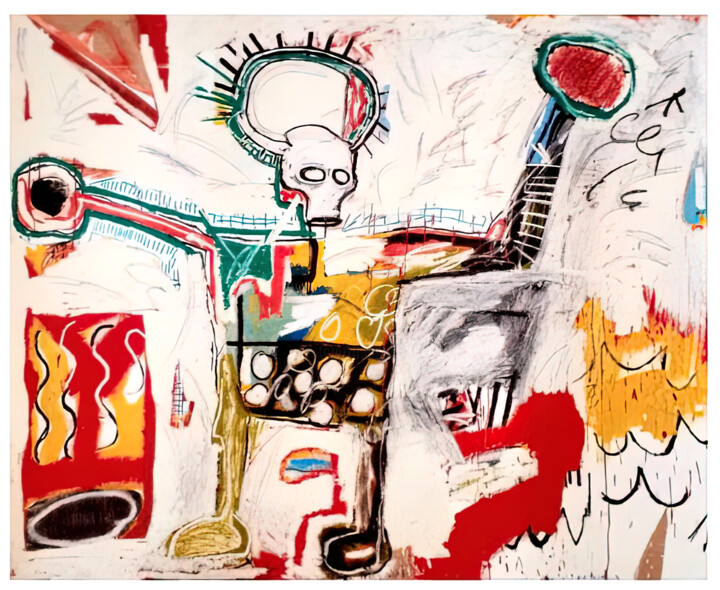Jean-Michel Basquiat (December 22, 1960 – August 12, 1988) was an American artist who gained fame in the 1980s as part of the Neo-expressionism movement. Initially known for his graffiti work under the pseudonym SAMO with Al Diaz, Basquiat's enigmatic epigrams became iconic in Manhattan's Lower East Side. By the early 1980s, he was exhibiting his paintings internationally, becoming the youngest artist to participate in Documenta in Germany at age 21 and to exhibit at the Whitney Biennial in New York at 22. His art explored themes of wealth, poverty, integration, segregation, and internal versus external experiences, often incorporating social commentary and critiques of racism and power structures. Basquiat's work has increased in value since his death at 27, with his 1982 painting Untitled selling for $110.5 million in 2017.
Artist Biography
Jean-Michel Basquiat, born on December 22, 1960, in Park Slope, Brooklyn, New York City, emerged as a prominent figure in the art world in the late 20th century. The second of four children, Basquiat's early life was marked by cultural diversity and personal challenges. His father, Gérard Basquiat, was a Haitian immigrant, and his mother, Matilde Basquiat (née Andrades), was of Puerto Rican descent, born in Brooklyn. Matilde played a significant role in nurturing Basquiat's artistic inclinations, taking him to art museums and enrolling him as a junior member of the Brooklyn Museum of Art.
A child prodigy, Basquiat learned to read and write by age four and exhibited a natural affinity for art, often drawing his favorite cartoons. His academic journey included attendance at Saint Ann's School, a private school where he created a children’s book with his friend Marc Prozzo. A life-changing event occurred in 1968 when Basquiat was hit by a car, resulting in a prolonged hospital stay during which his mother gave him a copy of Gray's Anatomy, a book that profoundly influenced his later artistic themes.
The separation of his parents and his mother's subsequent mental health struggles, which led to her institutionalization, impacted Basquiat deeply. Raised primarily by his father, Basquiat was fluent in French, Spanish, and English by age eleven. The family's move to Puerto Rico in 1974 and return to Brooklyn two years later saw Basquiat attend Edward R. Murrow High School. His rebellious nature led him to run away from home at fifteen, experiencing life on the streets and experimenting with drugs.
Basquiat's formal education concluded at City-As-School, an alternative high school in Manhattan, where he thrived in an environment that appreciated artistic talent. It was during this period that he, along with Al Diaz, developed the character SAMO, which became a pseudonym for their graffiti work around Lower Manhattan. SAMO's graffiti, characterized by satirical and poetic messages, gained public attention when The Village Voice featured an article on it in 1978.
His artistic pursuits extended to music when he co-founded the noise rock band Gray in 1979. During this time, Basquiat also connected with key figures in the New York art scene, including Glenn O'Brien, who featured him on the TV Party show, and artists like Keith Haring. His friendship with Andy Warhol, sparked by a chance meeting in 1980, was pivotal in his career. The two collaborated on numerous projects, blending Warhol’s pop art with Basquiat's distinctive style.
Basquiat's first solo exhibition at the Annina Nosei Gallery in 1982 marked the beginning of his rise to fame. His work, characterized by its raw energy, vibrant colors, and complex iconography, resonated with audiences and critics alike. Basquiat's participation in Documenta in 1982 and his subsequent exhibitions across the United States and Europe solidified his status as a major contemporary artist. Despite his success, Basquiat's life was marred by emotional turmoil and substance abuse, struggles that ultimately led to his untimely death on August 12, 1988, at the age of 27. Basquiat's legacy endures, with his work continuing to influence and inspire the art world.
The Artistry of Jean-Michel Basquiat: A Fusion of Cultures and Commentary
Jean-Michel Basquiat's artistic legacy is characterized by his focus on heroic figures—athletes, prophets, warriors, and musicians—often depicted with crowned or haloed heads, emphasizing intellect and spiritual elevation over physicality. His work combined poetry, drawing, and painting, merging text and image, abstraction and figuration, historical information, and contemporary critique.
Art critic Franklin Sirmans noted Basquiat's acute political and social commentary, which included critiques of colonialism and support for class struggle. He explored artistic legacies and classical traditions, projecting his perceptions of the world through suggestive dichotomies such as wealth versus poverty, and integration versus segregation.
Basquiat's early work included punk-inspired postcards and political-poetical graffiti under the pseudonym SAMO. His art often incorporated a range of media and surfaces, covered with words, letters, numerals, logos, and diagrams. He drew from diverse texts, including "Gray's Anatomy" and "Flash of the Spirit," and his mid-career featured multi-panel paintings dense with writing and collage. His collaboration with Andy Warhol during 1984-1985 marked a significant period in his artistic journey.
Basquiat produced around 1,500 drawings, 600 paintings, and numerous mixed media works. His drawings often featured words referencing racism, slavery, and black historical figures. His portrayal of heroes and saints, marked by crowns and halos, symbolized martyrdom and victory. Jazz musicians like Charlie Parker inspired works such as "Charles the First" and "Horn Players."
Anatomy and heads were significant in Basquiat's art, influenced by "Gray's Anatomy," which he received as a child. His depictions often conveyed vulnerability and cultural reclamation, with skulls referencing Haitian Vodou.
Basquiat's diverse heritage was a rich source of inspiration, incorporating Spanish and Nuyorican slang and elements of African-American history. His works addressed themes like institutionalized racism, as seen in "Irony of Negro Policeman" and "Created Equal." Despite his complex and nuanced style, some critics have noted that elements of Basquiat's commentary on black culture and modernity are often overlooked or misunderstood.
No Name NRO4 (1983) by Jean-Michel Basquiat
Jean-Michel Basquiat, No Name NRO4, 1983, Printmaking, Lithography on Paper, 101.6cm x 71.1cm
In No Name NRO4 (1983), Jean-Michel Basquiat's mastery of neo-expressionism and graffiti art converges in a striking lithograph. Set against a stark black background, the composition features a human-like figure delineated in white, its form suggestive yet abstracted. Basquiat's signature use of bold lines and stark contrasts captures the essence of urban street art, where every stroke carries a narrative weight. Hints of red and yellow add dynamic accents, imbuing the figure with a sense of urgency and vibrancy. These colors, typical of Basquiat's palette, symbolically evoke themes of life and struggle, echoing his exploration of dichotomies like wealth versus poverty and integration versus segregation.
The figure's presence, crowned or haloed in Basquiat's characteristic style, suggests a hero or saint, resonating with his fascination for historical and cultural icons. This portrayal reflects Basquiat's deep introspection into black identity and societal critique, themes recurrent in his oeuvre. Basquiat's approach to printmaking in No Name NRO4 underscores his fluidity across mediums, merging text and image, abstraction and figuration. Each element, from the graffiti-inspired lines to the evocative use of color, invites viewers to delve into the complexities of Basquiat's artistic universe—a realm where raw emotion meets intellectual discourse.
El Gran Espectaculo (History of Black People) (1983) by Jean-Michel Basquiat
Jean-Michel Basquiat, El Gran Espectaculo (History of Black People), 1983, Lithograph on Oversize Thick Paper, 54.5 x 30.25 inches
Printed in Italy, 2002, as part of an unnumbered limited edition for the exhibition at Chiostro del Bramante, Roma, with licensed authorized rights from the Estate of Jean-Michel Basquiat, Copyright 2002. Courtesy of Galerie Enrico Navarra.
Jean-Michel Basquiat's El Gran Espectaculo (History of Black People) lithograph, created in 1983 and revived in this rare estate exhibition print, stands as a testament to his groundbreaking artistic vision. Measuring 54.5 by 30.25 inches on thick paper, this piece commands attention with its bold composition and rich historical resonance. The artwork, originally a provocative and controversial creation by Basquiat, delves into themes central to his oeuvre—namely, the complex history and identity of Black people. Through Basquiat's distinctive style, characterized by raw, expressive lines and vibrant colors, the lithograph presents a visceral narrative that challenges societal norms and celebrates cultural heritage.
Printed in 2002 in a limited edition for the exhibition at Chiostro del Bramante, Roma, this lithograph exemplifies Basquiat's enduring influence and the continued demand for his artworks among collectors worldwide. Its archival quality ensures its longevity as a prized collectible, offering aficionados a rare opportunity to own a piece of Basquiat's legacy.El Gran Espectaculo (History of Black People) remains not only a striking visual testament to Basquiat's genius but also a poignant reflection of his commitment to challenging perceptions and fostering dialogue through art—a timeless addition to any serious art collection.
Iconic Artworks
Jean-Michel Basquiat, mentored by Andy Warhol, became legendary in the art world with his works that frequently break auction records. Notable pieces include Irony of a Negro Policeman (1981), reflecting on racism; The Field Next to the Other Road (1981), sold for $37.1 million; La Hara (1981), depicting urban violence, sold for $35 million; and Dustheads (1982), possibly his most famous work, sold for $35 million. His Untitled Skull (1982) fetched $110.5 million, setting a record. Other significant works include Versus Medici (1982), Warrior (1982), In This Case (1983), Flexible (1984), and Riding with Death (1988), showcasing his unique style and themes of race, identity, and death.
Exhibition History and Art Market
Praised for his raw, emotionally charged style, Basquiat's work often depicted frontal figures with exposed nerves and organs, sparking contemplation on existence and suffering. His art incorporated everyday words and symbols, serving as a poignant reflection of his astute political and cultural insights. Basquiat's aesthetic aimed to convey a deeply personal worldview, celebrated by figures like gallerist Niru Ratnam for its expressive commentary on contemporary society. Musician David Bowie lauded Basquiat's ability to distill chaotic experiences into coherent artistic expressions, drawing parallels to the innovative spirit of hip-hop culture. Despite acclaim, Basquiat faced criticism from Robert Hughes and Hilton Kramer, who viewed his ascent as driven by hype rather than artistic substance. However, Basquiat's supporters contend that his paintings resist simple interpretation, embodying a deliberate complexity that challenges viewers to explore deeper meanings.
Jean-Michel Basquiat’s artistic trajectory is marked by a series of significant exhibitions that showcase his evolution and enduring impact on contemporary art. His first public exhibition occurred at The Times Square Show in New York in June 1980, setting the stage for a meteoric rise in the art world. By May 1981, Basquiat had his inaugural solo exhibition at Galleria d'Arte Emilio Mazzoli in Modena, Italy, followed by his American solo debut at Annina Nosei Gallery in New York from March to April 1982. Throughout 1982, Basquiat's work gained international acclaim with exhibitions at prestigious venues such as Gagosian Gallery in West Hollywood, Galerie Bruno Bischofberger in Zurich, and the Fun Gallery in the East Village, underscoring his rapid ascent. Notable retrospectives include "Jean-Michel Basquiat: Paintings 1981–1984" at the Fruitmarket Gallery, Edinburgh in 1984, and subsequent showings at the Institute of Contemporary Arts in London and Museum Boijmans Van Beuningen in Rotterdam in 1985.
The Baghoomian Gallery in New York hosted Basquiat’s first retrospective in October to November 1989, a pivotal moment that affirmed his enduring legacy. His first museum retrospective, "Jean-Michel Basquiat," held at the Whitney Museum of American Art from October 1992 to February 1993, garnered widespread attention and traveled across prominent U.S. venues, including the Menil Collection, Des Moines Art Center, and Montgomery Museum of Fine Arts from 1993 to 1994.
In 2005, the Brooklyn Museum mounted a comprehensive retrospective titled "Basquiat," which later traveled to the Museum of Contemporary Art, Los Angeles, and the Museum of Fine Arts, Houston, cementing Basquiat's status as a pivotal figure in contemporary art. A significant focus on Basquiat’s sketches and poetry emerged in "Basquiat: The Unknown Notebooks," curated by the Brooklyn Museum in 2016 and later exhibited at the Pérez Art Museum Miami. Basquiat's influence continues to resonate globally with exhibitions like "Basquiat Before Basquiat: East 12th Street, 1979–1980" at the Museum of Contemporary Art Denver in 2017 and the critically acclaimed "Basquiat: Boom for Real" at the Barbican Centre, London, the same year. In 2019, the Brant Foundation in New York hosted a landmark exhibition featuring Basquiat’s works, drawing immense public interest.
Recent exhibitions further illuminate Basquiat’s enduring appeal, such as "Jean-Michel Basquiat: King Pleasure," curated by his family and showcased in New York and Los Angeles in 2022 and 2023. The Albertina in Austria presented the first museum retrospective of Basquiat's work in the country in 2022, while "Basquiat X Warhol" at the Brant Foundation in East Village explored his collaborations with Andy Warhol later that year. Basquiat’s profound impact on art and culture continues with ongoing exhibitions like "Seeing Loud: Basquiat and Music" at the Montreal Museum of Fine Arts in 2022, followed by "Basquiat Soundtracks" at the Philharmonie de Paris in 2023. His work remains a beacon for contemporary artists worldwide, evident in exhibitions such as "Basquiat: The Unknown Notebooks" at the Brooklyn Museum in 2023 and "Writing the Future: Basquiat and the Hip-Hop Generation" at the Museum of Fine Arts, Boston from 2020 to 2021.
The current exhibition, "Made on Market Street," at Gagosian Gallery in Los Angeles from March to June 2024, provides a focused exploration of Basquiat's prolific period in California, highlighting his influential works produced in Venice. Curated by Fred Hoffman with Larry Gagosian, this exhibition underscores Basquiat’s ongoing legacy and creative brilliance in a new context, further solidifying his position as a seminal figure in contemporary art.
Jean-Michel Basquiat's artistic journey soared in the 1980s with his paintings gaining prominence among collectors like Debbie Harry and Emilio Mazzoli, fueling demand during the Neo-expressionism era. By 1982, Basquiat's works commanded high prices, reflecting his rapid ascent in fame and artistic development. Despite early critiques, his paintings appreciated significantly, with annual earnings reaching millions by the mid-1980s. Following his death, Basquiat's market thrived, culminating in the record-breaking $110.5 million sale of Untitled at Sotheby's in May 2017, making him the most expensive American artist ever auctioned and marking the second highest price for a contemporary artwork at the time. The sale, which exceeded expectations and contributed substantially to Sotheby's total, was acquired by art enthusiast Yusaku Maezawa, who planned to exhibit the masterpiece at his Contemporary Art Foundation in Japan, highlighting its enduring cultural impact. However, Basquiat's legacy has faced challenges with authenticity, including notable controversies over disputed artworks and the dissolution of the Basquiat authentication committee in 2012.
Artists Inspired by Basquiat
Jean-Michel Basquiat's profound influence on contemporary art resonates strongly in the work of several notable artists, each reflecting his legacy through distinctive styles and thematic explorations. George Condo, a celebrated figure in the art world, channels Basquiat's spirit through his 'Artificial Paintings,' which blend Cubism, Surrealism, and Expressionism to probe deep into human identity and societal facades. His exploration of distorted portraiture mirrors Basquiat's raw and provocative approach, evoking critical dialogue and commanding high prices in prestigious markets worldwide.
Banksy, the enigmatic street artist, continues Basquiat’s legacy through satirical and subversive works that challenge political and social norms. Like Basquiat, Banksy critiques societal issues with stencil art, using visual narratives to provoke thought and reflect on contemporary culture. His pieces, often fetching millions at auctions, underscore his role as a significant contemporary voice akin to Basquiat’s disruptive influence.
Aboudia Abdoulaye Diarrassouba, aka Aboudia, hailing from Abidjan, Côte d’Ivoire, paints vibrant, large-scale canvases that capture the energy and complexities of urban life. His dynamic style, merging graffiti with traditional African art, echoes Basquiat’s aesthetic while highlighting social issues unique to his homeland. Aboudia’s rising market presence, with pieces reaching six-figure sums, reflects the growing appreciation for his narrative-driven art in global markets, much like Basquiat’s ascent in the 1980s.
Wes Lang, based in Los Angeles, infuses American iconography with themes of mortality and rebellion, drawing parallels to Basquiat’s exploration of identity and culture. His tattoo-inspired art, resonant with raw energy and personal commentary, offers collectors a connection to Basquiat’s expressive style at a more accessible price point.
Diego Tirigall, emerging from Argentina and now based in Spain, delves into digitalization’s impact on humanity through street pop art. Tirigall’s ironic and provocative narratives, influenced by Basquiat among others, challenge conventional art expectations while offering early investors a promising opportunity in the evolving art market.
Jean-Michel Basquiat's estate, initially managed by his father Gerard Basquiat until 2013 and now overseen by his sisters Jeanine Heriveaux and Lisane Basquiat, continues to influence contemporary art and culture. His impact on street art and hip-hop is profound, inspiring artists like Banksy, Shepard Fairey, and Halim Flowers. Basquiat's legacy has been celebrated posthumously, with honors including a Vanity Fair cover in 2015, a commemorative plaque at his former Manhattan residence, and accolades from Brooklyn Borough President Eric Adams. In 2017, Banksy created murals at London's Barbican inspired by Basquiat's work, coinciding with the exhibition "Basquiat: Boom for Real." His memory is also honored internationally, with a Parisian square named Place Jean-Michel Basquiat and the Brooklyn Nets paying homage through uniforms and an educational arts program funded by the Joe and Clara Tsai Foundation. Basquiat's influence extends into fashion, film, literature, and music, showcasing his multifaceted impact on culture. Known for his distinctive style, Basquiat frequently painted in Armani suits and collaborated with fashion icons like Issey Miyake and Comme des Garçons. His presence in fashion continued posthumously, with brands like Valentino and Sean John paying homage to his legacy through themed collections. In film and television, Basquiat starred in "Downtown 81" and was the subject of documentaries and biopics that explored his life and artistic journey. His influence also permeates literature, with books and graphic novels recounting his life and artistic contributions. In music, Basquiat's memory is honored through songs and album covers, such as the Strokes' use of his artwork on their album "The New Abnormal.
Born in 1960 in Brooklyn, New York, Jean-Michel Basquiat rose to prominence in the 1980s as a pivotal figure in Neo-expressionism and graffiti art. Initially recognized for his SAMO graffiti with Al Diaz, he gained international acclaim by his early twenties, becoming the youngest artist featured in Documenta and the Whitney Biennial. Basquiat's art explored complex themes including race, class, and societal structures, blending poetry, drawing, and painting to create vibrant, layered compositions. His work, characterized by bold lines, vivid colors, and symbolic iconography, often depicted heroic figures adorned with crowns or halos, reflecting his introspective exploration of identity and cultural critique. Basquiat's legacy endures through extensive exhibitions, significant market value, and influence across art, fashion, film, literature, and music, cementing his status as an iconic and enduring figure in contemporary art history.


 Selena Mattei
Selena Mattei

